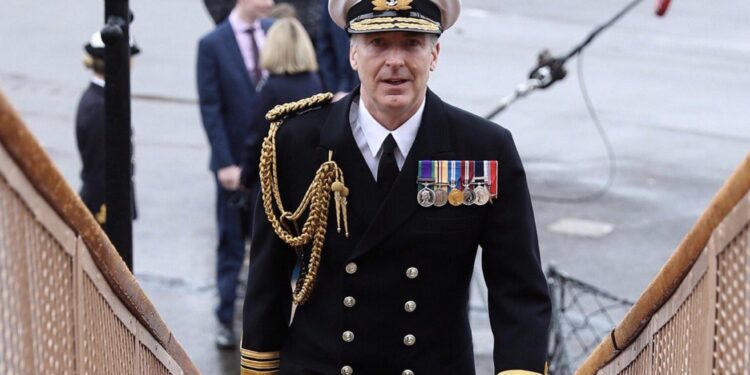The U.K. Royal Navy recently tracked a Russian submarine navigating the English Channel, underscoring ongoing maritime vigilance amid heightened geopolitical tensions. Concurrently, naval forces from the United Kingdom, United States, and the Netherlands conducted joint exercises off the U.S. East Coast, demonstrating allied commitment to regional security and interoperability. These developments reflect the increasing complexity of naval operations in contested waters and the strategic importance of maintaining a robust multinational presence.
U K Royal Navy Monitors Russian Submarine Activity in English Channel
In a recent display of maritime vigilance, the U.K. Royal Navy has been actively tracking a Russian submarine navigating through the strategic waters of the English Channel. This subtle but firm presence underscores the ongoing tension and the importance of maintaining control over one of the world’s busiest shipping lanes. Royal Navy vessels employed advanced sonar technology and aerial reconnaissance to monitor the submarine’s movements, ensuring that the delicate balance of regional security is not disrupted. Officials emphasize that such remote shadowing operations are vital for gathering intelligence without escalating tensions unnecessarily.
Meanwhile, extending their collaborative defense efforts, naval forces from the U.K., U.S., and the Netherlands conducted joint drills off the U.K.’s east coast. This multinational exercise focused on:
- Anti-submarine warfare tactics
- Coordinated naval maneuvers
- Real-time communication protocols
These drills not only reinforce interoperability but also serve as a clear message of unity among NATO allies amid increased Russian submarine activity in the region. A snapshot of the participating vessels highlights the varied capabilities contributed by each nation:
| Country | Vessel Type | Role |
|---|---|---|
| U.K. | Type 23 Frigate | Anti-submarine warfare |
| U.S. | Arleigh Burke Destroyer | Surface combatant |
| Netherlands | De Zeven Provinci√ęn-class Frigate | Air defense & ASW |
Joint Naval Exercises Strengthen U K U S and Netherlands Maritime Cooperation
The Royal Navy, U.S. Navy, and Royal Netherlands Navy recently concluded a series of coordinated drills off the East Coast, underscoring their commitment to enhancing interoperability and regional security. These exercises focused on advanced anti-submarine warfare, surface warfare tactics, and joint maritime patrol operations. Notably, the collaboration included real-time tracking and shadowing of underwater contacts, which simulated real-world scenarios involving potential threats in contested waters. The seamless communication and tactical synchronization between the three navies demonstrated their collective readiness to respond to evolving maritime challenges.
Key objectives achieved during the exercises included:
- Strengthening multi-national command and control protocols for effective decision-making in combined task forces
- Enhancing sensor data sharing to improve detection and tracking of submarines and surface vessels
- Conducting joint live-fire drills to validate precision targeting and combat coordination
- Improving logistics and resupply operations at sea to extend mission endurance
| Navy | Primary Role | Exercise Focus |
|---|---|---|
| Royal Navy (U.K.) | Anti-submarine warfare | Submarine tracking and shadowing |
| U.S. Navy | Surface combatant operations | Live-fire precision drills |
| Royal Netherlands Navy | Maritime patrol and surveillance | Sensor integration and data sharing |
Recommendations for Enhancing Surveillance and Defense Posture in Strategic Waters
To bolster monitoring capabilities and fortify defense measures in key maritime zones, it is imperative to invest in advanced sensor networks that enable persistent, real-time tracking of underwater and surface threats. Enhancing cooperation between allied navies through joint intelligence sharing and synchronized patrols will improve situational awareness and response times. Integrating unmanned maritime systems – including autonomous underwater vehicles (AUVs) and drones – can expand operational reach while reducing risks to personnel, especially in contested or sensitive areas such as the English Channel and the North Sea.
Key strategies recommended for implementation include:
- Multi-domain surveillance: Combining sonar arrays, satellite reconnaissance, and electronic signals intelligence for comprehensive coverage.
- Joint training exercises: Regular multinational drills that simulate realistic threat scenarios, enhancing interoperability.
- Rapid response frameworks: Streamlining command protocols and decision-making to accelerate defense maneuvers.
- Technology upgrades: Prioritizing investment in stealth-detection and cyber-defense systems.
| Capability | Current Status | Recommended Action |
|---|---|---|
| Underwater Detection | Moderate coverage | Deploy additional AUVs |
| Allied Communication | Fragmented systems | Establish secure, unified networks |
| Rapid Response Time | Varies by region | Coordinate joint command centers |
| Cyberdefense | Emerging capability | Increase dedicated security teams |
Wrapping Up
As geopolitical tensions continue to shape naval operations in key strategic regions, the recent shadowing of the Russian submarine by the U.K. Royal Navy in the English Channel underscores the heightened vigilance among allied forces. Concurrently, the joint U.K., U.S., and Netherlands drills off the U.S. East Coast demonstrate a commitment to interoperability and readiness in the face of evolving maritime challenges. These developments highlight the ongoing importance of multinational cooperation to maintain security and stability in international waters.
















